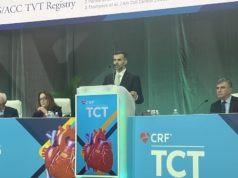
Data from the FITT-STEMI (Feedback intervention and treatment times in ST-segment elevation myocardial infarction) trial indicate that reducing the time between first medical contact and the initiation of angioplasty (balloon time) to less than 90 minutes would lower mortality for all STEMI patients. However, these findings also indicate that patients with cardiogenic shock would receive the greatest benefit from reducing this timeframe.
Karl Heinrich Scholz (Department of Cardiology, Medizinsche Klinik I, St Bernward Hospital, Hildesheim, Germany) and his fellow investigators sought to evaluate the prognostic significance of treatment delays between the first medical contact and coronary reperfusion in patients with cardiogenic shock and/or out-of-hospital cardiac arrest. They report in the European Heart Journal that while door-to-balloon time is known to be a predictor of outcomes after percutaneous coronary intervention (PCI), less is known about the prognostic value of contact-to-balloon time—particularly in patients with cardiogenic shock and/or out-of-hospital cardiac arrest, whose medical needs (such as resuscitation) may lead to delays in this timeframe.
Using data from FITT-STEMI, Scholz et al identified 12,675 PCI patients who received PCI within ≤360 minutes of first medical contact. Of these, 10,766 had neither cardiogenic shock nor out-of-hospital cardiac arrest, 369 did not have cardiogenic shock but did have out-of-hospital cardiac arrest, 699 had cardiogenic shock but not out-of-hospital cardiac arrest, and 831 had both cardiogenic shock and out-of-hospital cardiac arrest.
Overall, in-hospital mortality was lower among patients who had a contact-to-balloon time of <90 minutes compared with those with a timeframe of >90 minutes (3.9% vs. 12.2%; p<0.0001). Scholz et al report: “A particular high risk of death was observed in the group of patients with contact-to-balloon times ranging from 150 minutes to 190 minutes, as one-fifth of all patients out of this group died after PCI”.
Regardless of the contact-to-balloon time, patients with cardiogenic shock and/or out-of-hospital cardiac arrest had much mortality than patients without these factors. The authors note that they observed “pronounced beneficial effects” when patients with either cardiogenic shock or out-of-hospital cardiac arrest were treated within 90 minutes of the first medical contact. “By reducing the contact-to-balloon time to less than 90 minutes, one additional life could be saved out of five patients treated with cardiogenic shock. However, this number needed to treat was much higher in stable patients (one life additionally saved out of 53 patients),” Scholz et al comment.
Furthermore, the authors found that every 10 minute in contact-to-balloon time “resulted in 3.31 additional deaths” per 100 PCI-treated patients with cardiogenic shock but no out-of-hospital cardiac arrest. They state: “This treatment delay-related mortality was significantly higher as compared with the two groups of out-of-hospital cardiac arrest patients with shock and without shock, as well as haemodynamically stable patients.”
Scholz et al conclude that their data indicate that efforts to shorten time to PCI therapy should be applied to “all STEMI patients”, adding that patients with haemodynamic instability “may benefit most from future improvements in STEMI treatment protocols”.
Scholz told Cardiovascular News: “We believe that quality improvement measures with standardised data registration, systematic analysis and interactive feedback—which are all important components of the FITT-STEMI study protocol—should be implemented in local treatment networks in order to maintain a long-lasting impact on mortality in all STEMI patients. Continuous quality checks ensure that all professionals engaged in the treatment of STEMI patients will work together in order to shorten treatment times and impact on the survival especially in high-risk patients presenting with shock or out of hospital cardiac arrest.“










